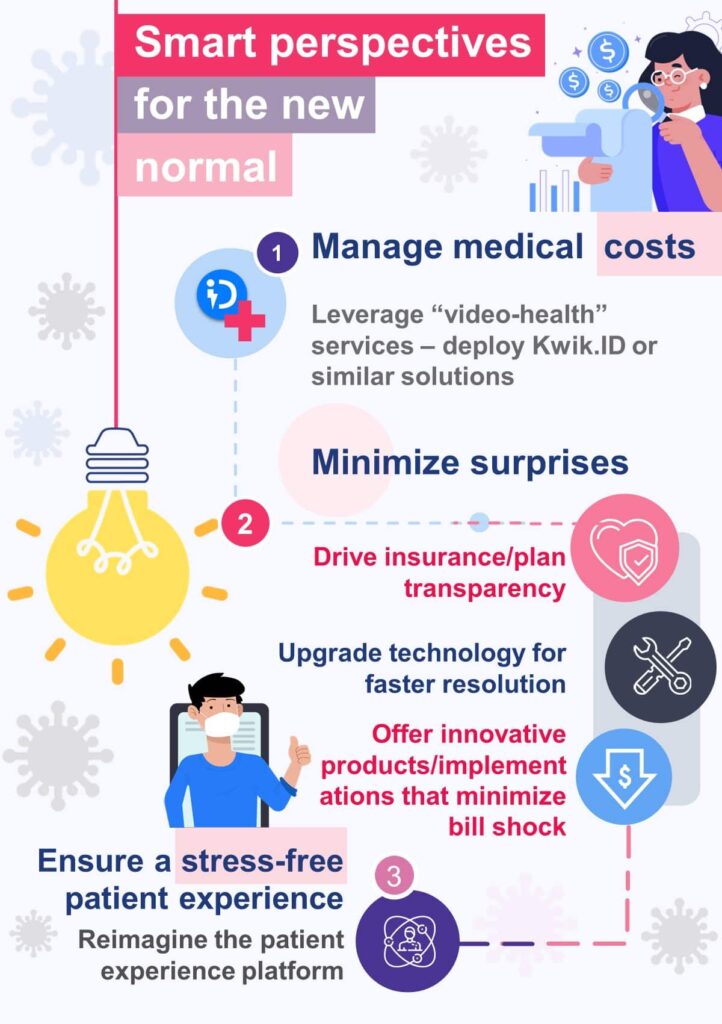The COVID-19 pandemic has resulted in a “mini pandemic” in the form of medical debt and patient stress. We need to be “smart” about managing it
The COVID-19 pandemic has affected the lives and livelihood of American families. At least 20 million people in the United States (US) are currently unemployed[1]—nearly59 percent of those had no insurance coverage as part of job benefits.[2]Around 79 million Americans, comprising working-age and elderly adults, are dealing with crippling medical debt since the spread of the pandemic.[3] While some have managed to payoff their debts, around 54 percent of people have defaulted on it.[iv]Almost 28 percent Americans have an outstanding balance of over USD 10,000 on their bills.[4] Further, around 5.4 million people were left uninsured due to job losses, aggravating the rising medical debt issue.[5]
Given the uncertain insurance status and high costs of COVID-19 intervention, many people are hesitant to get tested and are delaying emergency care. While there are provisions for free testing, people are still incurring significant costs due to operational loopholes. The facilities are unaffordable for those who wish to get care—COVID hospitalizations can easily incur a bill of approximately USD 75,000.[6]Even the deductibles are increasing for those who have health insurance.
Other complications are also adding to significant patient stress. There is lack of transparency in insurance co-pays, deductibles and coverage. Further, there is no standard approach for uninsured patients, with expenses varying between USD 20 and USD 850 per visit. One in five patients are receiving surprise bills.[7]For instance, one COVID survivor received a stunning hospital bill for USD 1.1million in Seattle.[8] Another patient received a bill for USD 400,000.[9]
In this scenario, we need to be “smart” in devising solutions or potential frameworks to better manage medical debt, minimize the “surprises” and ensure a stress-free patient experience.

Managing medical costs
- Leveraging tele-health/video-health services for lower costs: Currently, most remote video-interaction solutions suffer from a lack of industry and outcome-driven design thinking. They are designed as workflows that make the capability available, like a video-conferencing solution. The platform needs to be redesigned or modified to provide a better off-site diagnosis and intervention. Pre-incident proactive data-driven interventions can also help decrease the cost of care.
We have seen that implementing KwikID in Financial Services helps in reducing the cost of customer engagement systemically by 50 to 80 percent. Healthcare has a similar opportunity to redefine engaging customer experience sat a fraction of the traditional cost structures
Minimizing The “surprise” element
- Ensuring that insurers are transparent about their rates and expected costs: This would also mean that the people need to be better aware of all the available insurance information well before the time of admissions.
This can be achieved through a careful blend of technology and UX
- Developing tighter integration between bill components and claim adjudication: This integration might be possible through a better microservices architecture. Such a system would allow patients, payers, providers, benefits administrators, pharmacies and other stakeholders to seamlessly collaborate with each other and reduce the amount of confusion and uncertainty.
Organizations need to look outwards, rather than inwards, to enable this integration. Leveraging modern technology stack and innovation on the periphery of core systems can help achieve this through a robust microservices-based architecture and creative bespoke applications. Changing existing core systems always creates additional roadblocks due to system limitations.
- Focusing on reducing “surprise” bills and costs: We need to consider new designs for out-of-network coverage through a moderated interchange rate or any such similar mechanism that does not penalize the patient.
We believe that existing challenges would give rise to a new breed of insure tech start-ups designed to create benefits exchanges.
Ensuring a stress-free patient experience
- Reimagining the patient experience platform: Developing such a platform would help overcome the initial hiccups that most patient segments experience during remote care. This platform could reduce the patient’s physical and mental stress and enable physicians to make a more accurate diagnosis. Remote-care facilities can also significantly reduce the pressure that pre-and-post-illness phases have on the current medical infrastructure and costs.
Ref:
- https://www.washingtonpost.com/business/2020/04/16/unemployment-claims-coronavirus
- https://www.commonwealthfund.org/publications/issue-briefs/2020/jun/implications-covid-19-pandemic-health-insurance-survey
- https://www.commonwealthfund.org/publications/newsletter-article/survey-79-million-americans-have-problems-medical-bills-or-debt
- https://www.cnbc.com/2020/02/13/one-third-of-american-workers-have-medical-debt-and-most-default.html
- https://www.independent.co.uk/news/world/americas/coronavirus-health-insurance-pandemic-families-usa-report-a9617226.html
- https://www.cnbc.com/2020/04/01/covid-19-hospital-bills-could-cost-uninsured-americans-up-to-75000.html
- https://www.healthaffairs.org/doi/10.1377/hlthaff.2016.0970
- https://www.theguardian.com/commentisfree/2020/jun/16/coronavirus-hospital-bill-healthcare-america
- https://www.nytimes.com/2020/06/14/nyregion/coronavirus-billing-nyc.html



